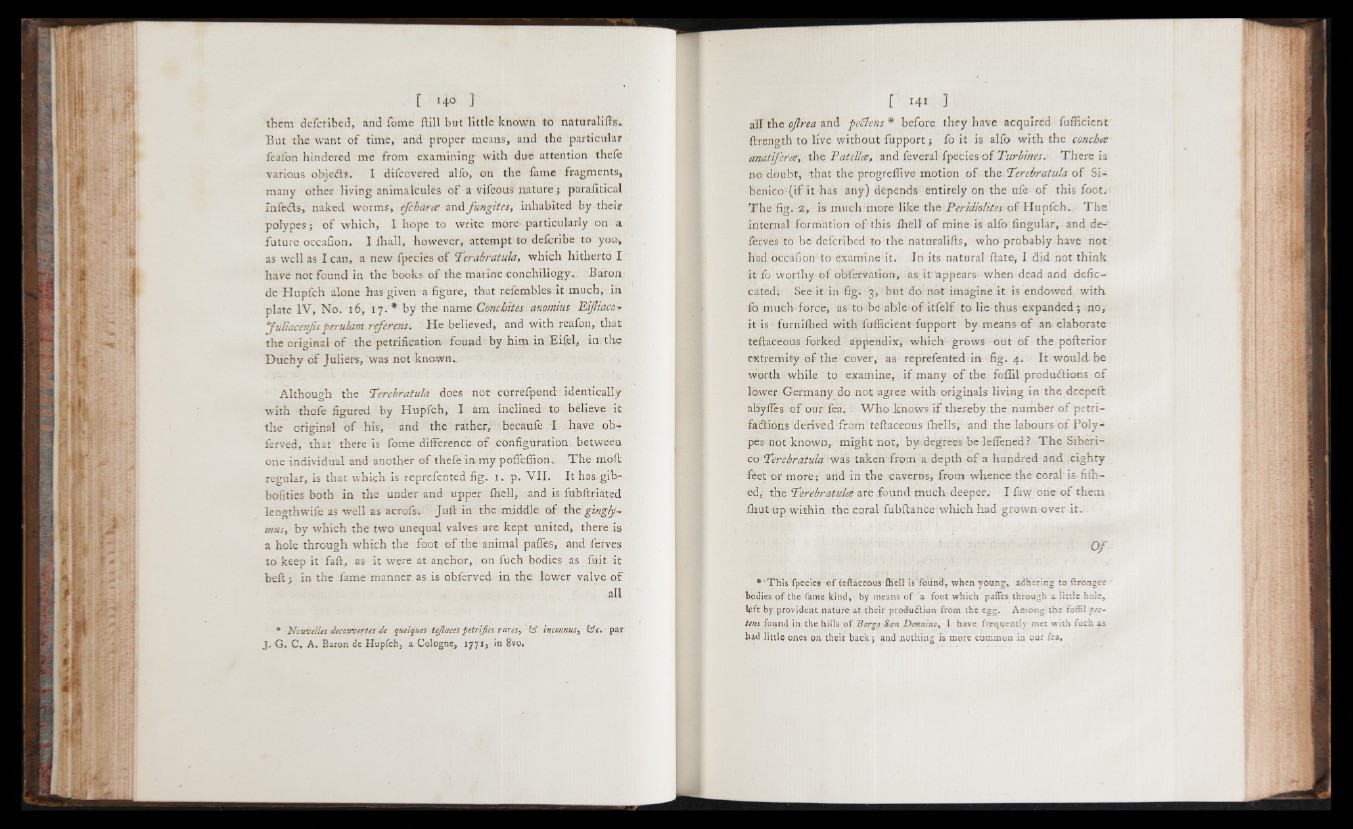
them defcribed, and feme Hill but little known to naturaliftsv
But the want o f time, and proper means, and the particular
feai'on hindered me from examining with due attention thefe
various objeits. I difcovered alfo, on the feme fragments,
many other living animalcules o f a vifcous nature j parafitical
fnfedls, naked worms, efchara and fungites, inhabited by their
polypes j o f which, I hope to write more- particularly on a
future oecafion. I ihall, however, attempt to defcribe to you,
as well as I can, a new fpecies o f Terabratula, which hitherto I
have not found in the books o f the marine conchiliogy. Baron
de Hupfch alone has given a figure, that refembles it much, in
plate IV , No. 16, 1 7 .* by the name Concbites anomius Eijliaco-r
JiiUacenJisperuhm referent. He believed, and with reafon, that
the original o f the petrification found by him in Eifel, imthe
Duchy o f Juliers, was not known..
Although the Terebratula does not correfpond identically
with thofe figured by Hupfch, I am inclined to believe it
the original o f his, and the rather, becaufe I have ob-
lerved, that there is fome difference of configuration, between
one individual and another o f thefe in-my poffeffion. The moil
regular, is that which is reprefented fig. 1. p. V I I . It has gib-
bofities both in the under and upper ihell, and is fubftriated
lengthwife as well as acrofs. Jull in the middle, o f the g'mgly~
mus, by which the two unequal valves are kept united,, there is
a hole through which the foot o f the animal paffes, and ferves
to keep it faff, as it were at anchor, on fuch bodies as fuit it
bell j in the fame manner as is obferved in the lower valve o f
all
* Nouvelles découvertes de quelques iejlaces petrifies rares, & inconnus, tâc, par
J. G . C , A . Baron de Hupfch, a Cologne, 1771, in 8vo.
all the ojlrea and peBens * before they have acquired fufficicnt
ftrength to live without fupport; fo it is alio with the concha
anatifera, the Patella, and feveral fpecies o f Turbines. There is
no doubt, that the progrefiive motion o f the. Terebratula o f Si-
benico (if it has any) depends entirely on the ufe- o f this foot.
The fig. 2, is much-more like the Peridiolites o f Hupfch. The
internal formation of this ihell o f mine is alfo lingular, - and deleaves
to be defcribed to the naturalifts, who probably have not
had occafion to examine it. In its natural Hate, I did not think
it fo worthy o f obfervation, as it appears when dead and defic-
cated; See it in-fig. 3, but do not imagine it is endowed with
fo much force, as to-be able o f itfelf to lie thus expanded ; no,
it is furniihed with fufficient fupport by means o f an elaborate
teilaceous forked appendix, which grows out o f the pollerior
extremity o f the cover,- as reprefented in fig. 4. It would.be
worth while to examine, i f many o f the foffiL productions o f
lower Germany do not agree with originals living in the deepeft
abyffes o f our fea .. Who knows i f thereby the number o f petri-
fadions derived from teilaceous ihells; and the labours o f Polypes
not known, might not, by degrees be leffened ? T h e Siberi-
co Terebratula was taken from a depth o f a hundred and eighty
feet or more; and in the caverns, from whence the coral is fidied,
the Terebratula are found much deeper. I faw one o f them
ihut up within the coral fubftance which had grown over it.
O f
• This fpecies o f teilaceous {hell is found, when young, adhering to ftronger
bodies of the fame kind, by means of a foot which'paffes through a little hole,
left by provident nature at their production from the egg. Among the foffil f t c -
tens found in the hiils of Borga San Donnmo, I have frequently met with fuch as
had little ones on their back; and nothing is more common in our fea.